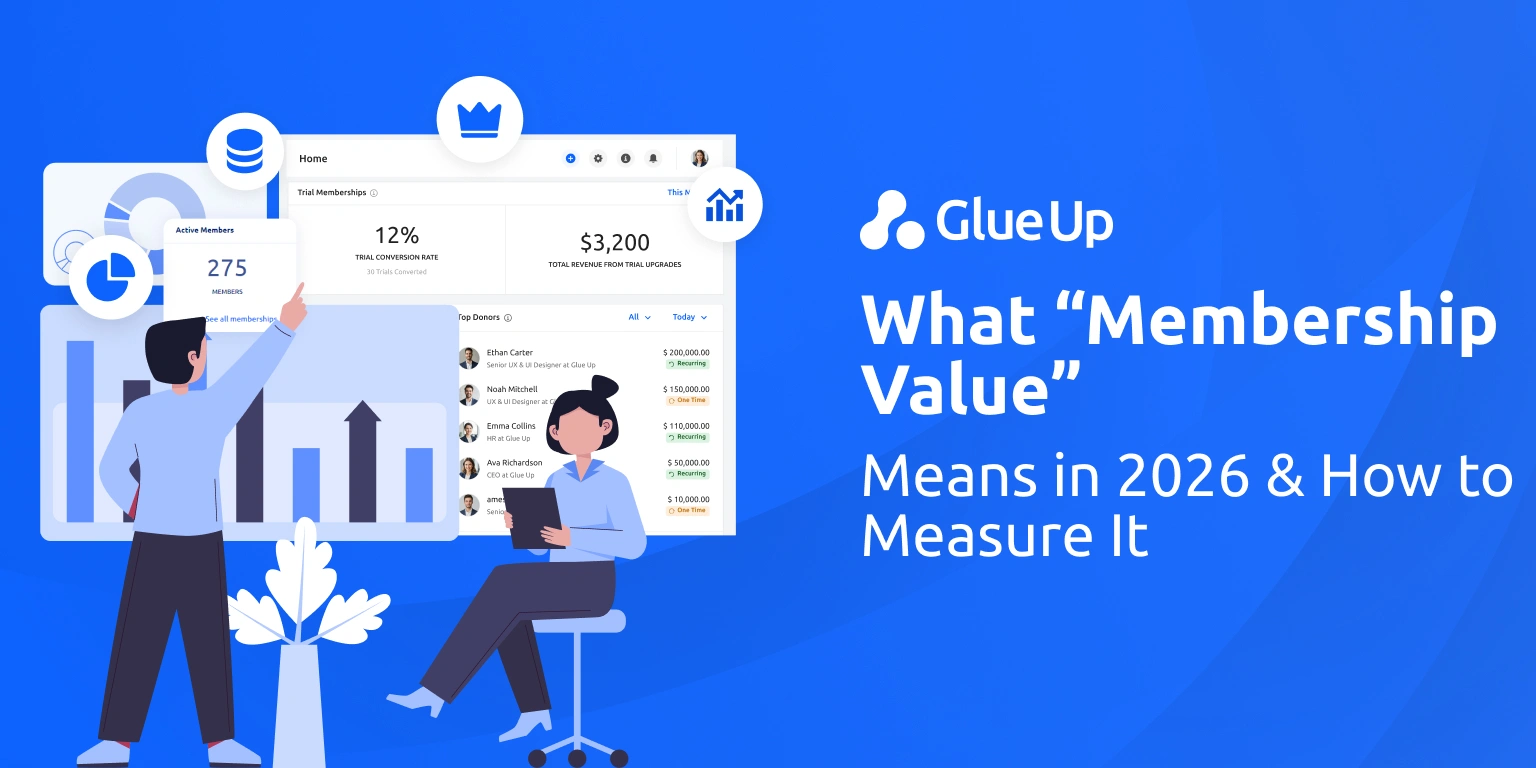
You open your renewal notice. There is a number. What you really want is a map. This article is that map, and it is the membership fees guide you can share with your board, your team, and your members with confidence. We will show where each dollar goes, how pricing decisions get made, how to communicate changes without drama, and how Glue Up helps you publish the story and keep renewals on track. Think of this as a plain-English operating manual for trust. It is specific, data aware, and practical, and it reads like something you would actually send to members.
Key Takeaways
Publish a clear “for every $100” breakdown, name operations as an investment, and tie each slice to outcomes members can feel.
Use a structured pricing system, tiered or sliding scale with a cost-plus floor and value-based ceiling, document chapter pass-throughs, and offer installments or trials where it truly helps.
Run an annual light review with a cross-functional pricing committee, benchmark peers for context, and ground decisions in real usage and renewal data from Glue Up.
Communicate changes 60–90 days ahead, lead with benefits, show old vs. new side by side, highlight one recommended tier, and answer questions in a short FAQ.
Protect retention with predictable adjustments, strong onboarding, fair loyalty options, and timely outreach to drifting members, supported by Glue Up’s renewals, smart lists, and engagement signals.
Quick Reads
Online Payment Methods for Membership Organization • Glue Up
Event Management Platform for Modern Organizations • Glue Up
Predictive Analytics Membership CRM Growth Signals • Glue Up
What Your Dues Actually Fund, A Membership Fees Guide Map
Members do not care about abstract categories. They care about outcomes. A useful membership fees guide starts with a simple promise. For every 100 dollars of dues, here is what you are funding, and here is what you get for it.
For every 100 dollars of dues, a sample split
Programs and services, 28 dollars: Training, certifications, resource libraries, and helplines. Members should feel this every month through better content, office hours, and real people who answer questions. The outcome is skill growth and confidence.
Events and education, 22 dollars: Your annual meeting, regional workshops, and webinars. Members see lower member pricing, better production, and more relevant sessions. The outcome is stronger networks and deal flow.
Policy and advocacy, 16 dollars: Briefings, comment letters, coalition work, and direct representation where rules get set. The outcome is a voice that protects member interests.
Member support and success, 12 dollars: Response time, onboarding help, and a real support desk. The outcome is fewer blockers and faster resolutions.
Technology and operations, 15 dollars: Secure systems, a reliable database, payments, and mobile access. This is also where Glue Up shows up. The outcome is fewer errors, better data, and easier renewals.
Chapters and affiliates, 5 dollars: Local programming and regional support. The outcome is relevant activity close to home.
Reserves and risk, 2 dollars: Stability during shocks, and the capacity to keep serving when revenue or events wobble.
Adjust the numbers to your reality, then publish them with one sentence under each slice that states the outcome members should feel. A good membership fees guide makes the connection explicit. Money buys outcomes.
The Overhead Myth Explained, A Membership Fees Guide for Plain English
Operations are not waste. Operations are the machine that turns dues into service. That means security, uptime, payroll, compliance, insurance, accounting, and software. When people say overhead as if it were a secret, they invite suspicion. When they say operations with proof, they build trust.
Your membership fees guide should name operations as an investment. Explain it like this. We invest in operations so your experience is faster, safer, and simpler. That investment keeps your card data safe, your login working, your records accurate, and your support answers quick. It also keeps your auditors and regulators satisfied, which protects the reputation that members rely on when they attach their brand to yours.
One more truth. If operations feel invisible, that is because they are working. If they fail, everyone notices. Say that out loud, then show two or three operational improvements you made this year. Faster page load. Better deliverability on email. Fewer refund tickets. A strong membership fees guide does not defend operations. It demonstrates outcomes.
A Membership Fees Guide to Pricing Models
Price is not a single number. Price is a decision system. The right system matches value and ability to pay, covers cost, and keeps incentives clean. Your membership fees guide should explain the models in simple terms, when they fit, and how to decide.
Tiered pricing
Create clear bundles for distinct needs. Individual. Small organization. Enterprise or institutional. Tie benefits to outcomes that segment actually wants. Early career discounts only if a real path exists into the next tier. Do not keep adding features to every tier until nothing is comparable. Simplicity wins.
Sliding scale or ability to pay
If your mission serves a wide range of budgets, tie dues to revenue bands, headcount, or career stage. Publish the criteria. Make the math visible. A sliding model shows fairness when value is uniform, but capacity differs.
Cost plus floor with value-based ceiling
Set a floor that covers delivery costs with a normal margin. Then set a ceiling based on outcomes members actually value. Time saved, access gained, deals closed, risk reduced. This respects finance and strategy at the same time.
Installments and trials
Where cash flow or risk aversion slows adoption, offer monthly or quarterly payments, or a defined trial. Make rules clear. Installments improve completion when renewal automation is in place. Trials work best when onboarding and engagement are strong in the first thirty to sixty days.
Chapters and pass throughs
National and local splits deserve clarity. Publish the formula. Show the flow of funds. If a member pays once and two entities benefit, state the numbers and the reasons. A good membership fees guide removes mystery from chapter finance.
Use Glue Up reports to pull historical attendance, course usage, and engagement by segment. That gives you honest signals for tier construction. Use smart lists when you announce changes to different segments. Use invoicing, auto renewals, and payment plans to support installments without extra spreadsheets. When operations are simple, pricing can be humane and confident.
How We Decide When to Adjust Dues, A Membership Fees Guide Process
If price moves only when the budget breaks, members feel whiplash. A steady light review avoids shocks. The process is simple, and your membership fees guide should publish it.
Timing
Review once a year. Do not skip. Small, planned adjustments beat sudden jumps.
Inputs
Consider inflation for venues and vendors, salary benchmarks for staff retention, program usage trends, satisfaction scores, event performance, competitor medians, and reserve targets. If advocacy work has intensified because of new rules, name it. If technology saved costs, pass some savings on or invest them in quality.
Deliberation
Use a cross functional pricing committee. Finance, membership, programs, marketing, chapters, and a board representative. Meet with a short brief. Decide within a defined window. Publish a two-page summary of the inputs, the decision, and the expected outcomes.
Documentation
Log the decision and the assumptions. Next year, you will compare outcomes to intent. A membership fees guide is not only a page on your site. It is a living record of how you steward dues.
Pull renewal cohorts, event revenue, and engagement from Glue Up. You can see whether a segment is thriving or stuck, then decide whether the issue is price or value. That keeps debate grounded in evidence, not instinct.
Communicating Changes Without Losing Trust, A Membership Fees Guide Playbook
Price changes do not cancel relationships. Surprises do. Your membership fees guide earns trust when communication is early, clear, and member first.
Lead time
Announce sixty to ninety days before renewal. If you bill on different cycles, create calendar reminders. Early notice lets people plan. Planning protects goodwill.
Message content
Start with what will get better. Members want to hear the outcomes you will improve because of the change. Faster verification of applications. More instructors. More chapter events. Better accessibility. Then explain the math. Inflation and vendor costs went up by this much. Program demand rose by this much. Your reserve target is here. The new price funds the promised outcomes.
Choice architecture
When you present tiers, show the current plan beside the new plan. Highlight one recommended option that aligns with most members. Offer installments if cash flow is a concern. Use simple words. Avoid jargon.
Channels
Use branded emails, your community portal, event announcements, and a pinned member post. Open a short Q and A window. Commit to an update summary after the window closes.
FAQ
Publish a brief FAQ inside the membership fees guide with ten questions. How will this affect students. Why operations are visible. How local chapters benefit. How to give feedback.
Glue Up sends friendly reminders, schedules renewals, and targets the right segment with smart lists. That means fewer missed notices and fewer angry surprises. It also means cleaner reporting on who opened, who clicked, and who replied.
Pricing And Retention Strategies That Work, A Membership Fees Guide for Outcomes
Retention follows perceived value more than sticker price. If members feel progress, they stay. A membership fees guide that promises outcomes and then delivers them creates a flywheel.
Small planned increase
A one or two percent increase each year with clear outcomes is easier to accept than a large jump after years of silence. Predictability feels respectful.
Onboarding that shows benefits early
The first thirty days after a renewal or a new join decide sentiment. Send a short orientation email. Point to two resources. Invite them to one event. Ask one question in the community. Do not bury the call to action.
Loyalty that feels fair
Offer multiyear options with a small price advantage. Bundle training with core membership for those who use it most. Provide a credit for inviting a new member who actually joins.
Signals that someone is drifting
If event attendance drops, or logins fall, or emails go unopened, treat it as a coaching moment. Reach out with a short message that offers three things they might value now. Often the issue is not price. It is fit and timing.
Glue Up automates renewal sequences, nudges inactive members, and surfaces engagement signals. When you know who is drifting, you can respond with care and speed rather than guesswork.
Competitor Benchmarking in Practice, A Membership Fees Guide Workflow
Benchmarking is not copying. Benchmarking is context. It tells you where the market sits, then you decide where you belong. Your membership fees guide should show a simple four step workflow.
Step One: Define the peer set
Pick ten to twenty organizations that match your size, region, and audience. National trade groups with similar advocacy scope. Professional societies with similar credential programs. Chapters with similar geography.
Step Two: Collect public data
Visit pages and capture dues by tier, term, and any onboarding fee. Capture what benefits are included, and which are add ons. Note event discounts, credential pricing, and sponsor exposure if relevant.
Step Three: Normalize value
Create a light rubric. Education hours. Government affairs reach. Data tools. Chapters offered. Annual event scale. Score each peer on those items. The rubric does not need to be complex. It needs to be consistent.
Step Four: Position your tiers
Compare your tiers against the median. If your value is clearly higher in two or three important areas, a higher price makes sense. If your value is lower on most dimensions, either raise the value or adjust the price. Then document why.
A good membership fees guide shares the method. It does not list every competitor. It shows that your price is principled.
Common Pitfalls to Avoid, A Membership Fees Guide Checklist
Hiding the why
If people only see the new number, they fill in the story themselves, and they often assume the worst. Explain your reasons and your outcomes.
Waiting too long to update
If inflation compounds for years, you will face a large jump and a reputational hit. Small, planned updates protect both budget and sentiment.
Copying rivals without checking value
Your members are not theirs. Your program mix is not theirs. A membership fees guide must reflect your real strengths.
Overstuffing tiers
If every tier has everything, people default to the cheapest option or do nothing. Make the middle option the clear best choice for most members. Keep the table simple enough to scan in ten seconds.
Treating operations as a secret
Operations are an investment that keeps promises. Name them. Show outcomes.
Frequently Asked Questions
How can organizations improve transparency about dues allocation?
Publish a yearly Where Your 100 Dollars Go chart, add one outcome line per slice, show what changed, and link to a short financial summary. Keep labels in plain English, and keep the story human.
What are best practices for communicating membership fee breakdowns?
Limit your chart to five to seven slices, add short captions, and place a brief note from the executive director beside it. Then pin a Q and A thread in your community for two weeks and commit to a summary reply.
How do membership fees typically support club activities and services?
They fund the things people notice and the things they do not. The visible items are programs, events, and advocacy. The less visible items are member support, technology, and reserves. Your membership fees guide should connect each item to a benefit the member can feel.
What factors influence membership fee structures across different organizations?
Member type and size, geography, benefits mix, advocacy scope, chapter structure, and reserve policy. Economic conditions and vendor costs also matter. Your bylaws and your mission may set guardrails. Own those in the guide.
How can members engage in discussions about fee adjustments?
Create a pricing committee, hold office hours, post a community thread, and provide a short form for feedback. Publish a summary of what you heard and what you changed. If your bylaws require a vote, give people a clear ballot and a stable formula.
How can I determine the right membership pricing model for my organization?
Cover cost first, then price to outcomes. Pick a tiered or sliding scale structure that matches your audience, test annually, and use real usage data from systems like Glue Up to validate. A membership fees guide should include the method and the schedule, not just the numbers.
What strategies improve member retention through pricing adjustments?
Move gradually, communicate early, show outcomes, and support cash flow with installments or multiyear options. Focus your first thirty days on visible wins. Renewal follows value and predictability.
How to analyze competitor membership fees effectively?
Define your peer set, collect public prices and benefits, apply a simple value rubric, and position yourself relative to median with a clear reason. Document the logic inside your membership fees guide so the story is easy to retell.
What are the common mistakes to avoid when setting membership fees?
Silence, imitation, complexity, and shame about operations. Replace those with narrative, benchmarking, simplicity, and pride in the systems that keep members safe and served.
How often should I review and update my membership pricing structure?
Review annually at minimum. Update when costs, demand, or strategy shift, and explain the reasoning two months ahead of renewal. Even if you do not change the number, publish the review note. That single habit builds credibility.
Why Clarity Wins and How Glue Up Helps
Price is a number. Trust is the story behind it. A strong membership fees guide gives people the story. Where dues go. Why the structure makes sense. When and how changes happen. It treats price as governance. It treats members as adults who can handle the truth if you give it to them early and clearly.
Glue Up helps you keep that promise. You can publish your breakdown with a clean chart. You can segment messages with smart lists and send notices on a schedule. You can set auto renewals, installments, and friendly reminders that respect member time. You can monitor engagement and reach out before someone drifts. You can pull real history when the pricing committee meets, so decisions rest on evidence, not hunches.
If you want a ready to publish dues page, cleaner renewals, and reporting that supports calm board conversations, book a demo today. We will show you how to turn your membership fees guide into living practice, so members see exactly what their money makes possible and feel good about staying another year.



